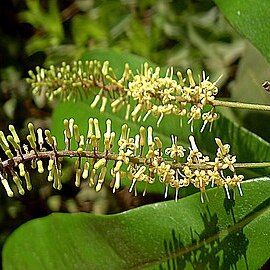Shrubs or trees to 25(-40) m tall. Leaves entire, simple, sessile to petiolate, arranged in verticels of 4, offset verticels, decussate, subopposite-decussate or spiral; blades at base sometimes descending petiole on either side, margin not markedly revolute, indument usually present when young, glabrescent, persistent for longer beneath, and above along midvein, less frequently remaining densely pubescent beneath; venation conspicuous to obscure, plane to slightly raised above, more conspicuous and prominent beneath, fractiflexed brochidodromous, frequently eucamptodromous at base, marginal vein weak, derived from ascending lateral veins, midvein raised, plane or more frequently sunken above, prominent and longitudinally ridged beneath, higher order venation reticulate. Inflorescences usually terminal, sometimes lateral or subterminal, unbranched and raceme-like, or branched and panicle-like, bearing lateral inflorescences subtended by leaves which are reduced in size to ligulate and bract-like structures on uppermost inflorescences; lateral inflorescences at times further branched; common bracts subtending flower pairs, caducous, small, ligulate, pubescent on outside, glabrous within; inflorescences subtended by mature leaves or by leaves considerably smaller in size; flowers paired, clustered at short intervals along rhachis (sometimes distinctly whorled) or randomly spread along racemes and branches; pedicels pubescent to pilose. Flower buds elongate or elongate-pyriform, opening apically by elongation of the style. Flowers essentially actinomorphic to slightly zygomorphic, tepals strongly recurved, pubescent to pilose outside, glabrous within; free parts of filaments ribbon-like, adnate to tepals below half-way, or completely free, anthers oblong to elliptic to widely ovate, connective apiculate; hypogynous gland tubular, thin, membranous, 4-lobed, lobes acute to apiculate, eventually shrinking and fragmenting; ovary stipitate, yellow-orange to orange villous outside, glabrous within, style straight-sided to clavate, longitudinally ridged, stigma absent, a specialised stigmatic surface developing at times, ovules 2, collateral, orthotropous, pendulous. Fruit 1-seeded, either globose with rounded to varyingly mucronate apex, surface smooth or scaly, semi-shiny to dull, glabrescent, or fusiform, strongly sutured, corrugate, with indument; pericarp usually with fleshy, granular outer mesocarp, woody, vascularized mid mesocarp, and thin, fleshy inner mesocarp; seed coat thin, often fused to pericarp; seed large, fleshy, rounded, not winged (laterally compressed in P. rubescens).
More
Trees. Leaves alternate, opposite or verticillate, entire, simple. Inflorescences racemes, terminal or axillary, bracts small or 0. Flowers bisexual, actinomorphic. Tepals free. Stamens inserted below the middle of the perianth, the anthers oblong, connective apiculate, the filaments obvious. Disc cupuliform, 4-lobed. Ovary subsessile, with 2 pendulous ovules, the stigma terminal. Fruit indehiscent with a thick woody pericarp and 1 exalate seed.

